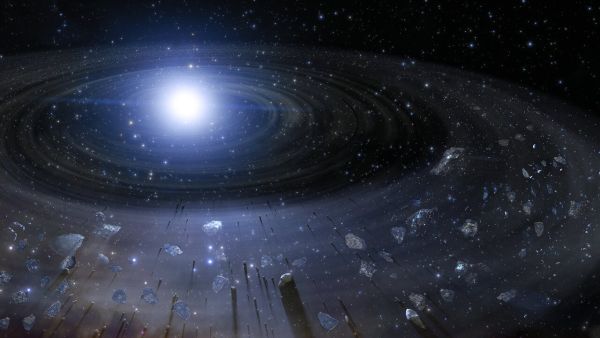An Earthlike planet may be orbiting in a dead star's 'habitable zone'
A regular pattern of debris suggests some kind of a planetary 'shepherd' in the region, scientists say.

Planetary debris, including some objects the size of moons, may hint at a rocky exoplanet within the habitable zone of a stellar zombie, a new study suggests.
The star in question is a white dwarf called WD1054–226, a cooling remnant of a star that exhausted all fuel at its core. If an exoplanet is confirmed in the system, it would be a breakthrough for white dwarf science, the researchers noted in a statement. Only one other planet has been discovered to date orbiting a white dwarf. That planet, however, is a gas giant, a planet similar to Jupiter, and not near the habitable zone, or Goldilocks zone (usually defined as where liquid water may exist on the surface of a rocky planet).
"The possibility of a major planet in the habitable zone is exciting and also unexpected; we were not looking for this," Jay Farihi, an astrophysicist at University College London and lead author of the study, said in a statement.
Fahiri cautioned that confirming the planet's existence with current technology will not be straightforward. "Confirmation may come by comparing computer models with further observations of the star, and orbiting debris," he said.
Related: First discovery of planet orbiting dead star provides glimpse into our solar system's future
WD1054–226, only 117 light-years away from Earth, is close enough to be observed directly by numerous telescopes.
The researchers realized a planet might be orbiting the white dwarf from "pronounced dips in light" detected by the European Southern Observatory's 3.5-meter New Technology Telescope at La Silla Observatory in Chile. Additional observations with NASA's planet-hunting space telescope, the Transiting Exoplanet Survey Satellite (TESS), shed more light on why these brightness changes may be occurring.
Get the Space.com Newsletter
Breaking space news, the latest updates on rocket launches, skywatching events and more!
WD1054–226's dips in luminosity match with 65 "evenly spaced" planetary debris clouds that go around the star every 25 hours, the data suggests. The regular distribution of the debris in space suggests a terrestrial planet (similar in size to Earth) might be keeping everything in place.
White dwarfs provide a bit of a preview of what will happen in our own solar system when the sun runs out of hydrogen in about five billion years. Before collapsing into the underwhelming white dwarfs, stars go through the so-called red giant phase. expanding a 100 to a 1,000 times and burning the planets closest to them. When the sun turns into a red giant, life on Earth will no longer be possible. Temporarily, the habitable zone will move towards the outer solar system, before shrinking again to include only the closest surroundings of the cooing white dwarf.

The theoretical planet at WD1054–226 is well within the white dwarf's habitable region. It orbits at a distance of 1.6 million miles (2.5 million kilometers) from the parent star, about 28 times closer than Mercury is to the sun.
More intriguingly, all the debris and the possible planet must have formed or somehow arrived in the area after the red giant collapsed into the white dwarf. That's because the material is so close that it would have been devoured by the red giant.
"It is expected that this orbit around the white dwarf was swept clear during the giant star phase of its life, and thus any planet that can potentially host water and hence, life, would be a recent development," the statement added. "The area would be habitable for at least two billion years, including at least one billion years into the future."
A paper based on the research was published Feb. 8 in the Monthly Notices of the Royal Astronomical Society.
Follow Elizabeth Howell on Twitter @howellspace. Follow us on Twitter @Spacedotcom and on Facebook.
Join our Space Forums to keep talking space on the latest missions, night sky and more! And if you have a news tip, correction or comment, let us know at: community@space.com.

Elizabeth Howell (she/her), Ph.D., was a staff writer in the spaceflight channel between 2022 and 2024 specializing in Canadian space news. She was contributing writer for Space.com for 10 years from 2012 to 2024. Elizabeth's reporting includes multiple exclusives with the White House, leading world coverage about a lost-and-found space tomato on the International Space Station, witnessing five human spaceflight launches on two continents, flying parabolic, working inside a spacesuit, and participating in a simulated Mars mission. Her latest book, "Why Am I Taller?" (ECW Press, 2022) is co-written with astronaut Dave Williams.









